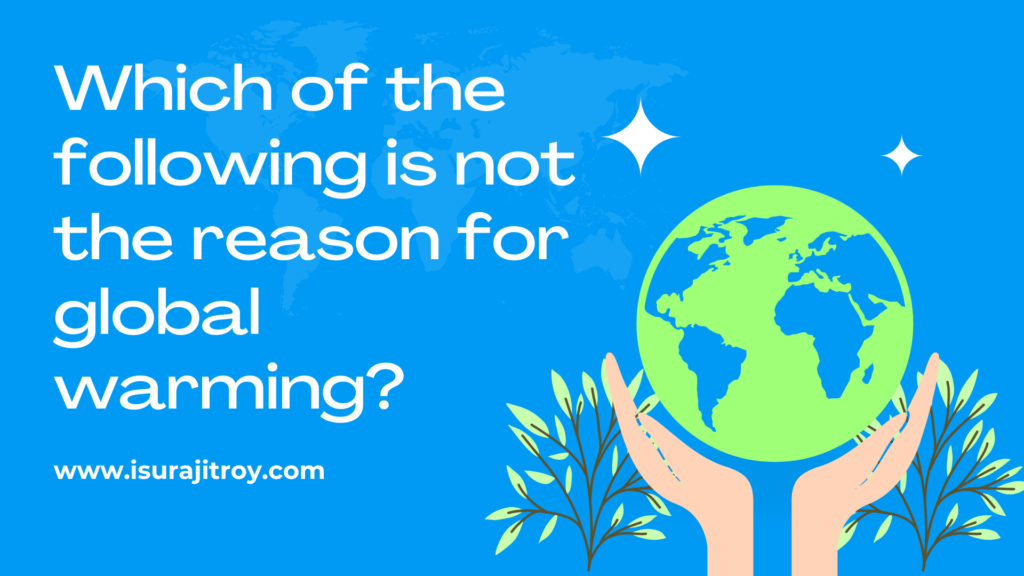
In the face of rising temperatures and intensifying weather events, the question of “Which of the following is not the reason for global warming?” becomes increasingly crucial. While human activities are often readily identified as the culprit, some proposed causes can be misleading. This article delves into the potential red herrings often cited in the global warming debate, separating fact from fiction. We’ll explore natural phenomena, atmospheric changes outside of greenhouse gas influence, and even biological factors to expose the true drivers of our planet’s warming trend. This exploration will empower you to navigate climate conversations with clarity and accuracy. Stay tuned as we shed light on the genuine threats fueling global warming and dispel common misconceptions.
Three Natural Phenomena NOT Driving Global Warming:

Ever wondered, “Which of the following is not the reason for global warming?” Look no further! This section dissects common misconceptions about natural phenomena like volcanic eruptions, solar activity, and orbital shifts. We’ll expose why these, while impactful, aren’t the true drivers of our planet’s rising temperatures. Get ready to separate fact from fiction and discover the genuine culprits behind global warming.
Volcanic Eruptions:
While large eruptions spew greenhouse gasses, their impact is temporary and dwarfed by human emissions. Think of it like adding a bucket of water to a swimming pool compared to a constantly running hose. The sustained warming from human activities, primarily CO2 emissions, is like that ever-flowing hose, causing a much more significant and long-lasting temperature rise.
Solar Activity:
The sun’s energy output does fluctuate, but these changes are subtle and occur over decades to centuries. The current warming trend is happening much faster, within mere decades, and aligns perfectly with the sharp rise in greenhouse gasses since the Industrial Revolution. Imagine the sun’s influence as a slow dimmer switch, while human activity is like throwing open the curtains—the impact on the room’s brightness is vastly different.
Earth’s Orbital Shifts:
Our planet’s orbit around the sun undergoes cycles that affect incoming solar radiation, but these cycles operate on vast timescales, ranging from thousands to hundreds of thousands of years. The current warming trend is happening at an unprecedented rate, incompatible with these slow, natural cycles. It’s like comparing the rapid heating of a pot on the stove to the gradual warming of a planet over millennia—completely different mechanisms and timescales.
Remember, natural phenomena can influence Earth’s climate, but the current rapid warming points clearly to human activity as the dominant driver.
Atmospheric Composition Changes NOT Warming the Planet:

While changes in the atmosphere can certainly impact Earth’s climate, not all alterations contribute to warming. Take nitrogen, the most abundant gas, for instance. It acts more like a thin sheet than a heat-trapping blanket, letting sunlight in but not effectively holding onto outgoing heat. Understanding “Which of the following is not the reason for global warming?” requires examining beyond just atmospheric presence; it’s all about the specific gas and its ability to trap heat that truly drives the issue. Dive deeper with us to explore other atmospheric elements and separate climate myths from facts!
Nitrogen Fluctuations:
While nitrogen is the most abundant gas in our atmosphere, it acts more like a thermal blanket than a greenhouse gas. It allows sunlight to pass through but doesn’t effectively trap outgoing heat, unlike CO2 and other culprits. Imagine nitrogen molecules as thin sheets; they provide some insulation but not enough to significantly warm the room compared to thicker, heat-trapping blankets.
Aerosols and Clouds:
Though they can influence temperatures, some atmospheric particles, like aerosols, have complex effects. While volcanic ash or industrial soot can reflect sunlight and cool the planet temporarily, other types, like black carbon, absorb heat, contributing to warming. It’s like having both black and white curtains; opening the white ones cools, but the black ones trap heat, and their combined effect depends on which ones are more prevalent.
Ozone Depletion:
The thinning of the ozone layer allows more harmful ultraviolet radiation to reach Earth, but this doesn’t directly contribute to global warming. In fact, it might indirectly cool the planet, as some greenhouse gasses are broken down by UV radiation. Think of it as fixing a leaky roof while someone keeps turning up the furnace—addressing one issue doesn’t fix the other.
Remember, focusing only on specific atmospheric components misses the bigger picture. Greenhouse gasses like CO2, with their unique ability to trap heat, are the primary drivers of current global warming.
Viral Evolution – Not a Culprit in Global Warming:

Forget mutant viruses, the answer to “Which of the following is not the reason for global warming?” might surprise you! Dive into the truth behind viral evolution and climate change. We debunk the myths and expose the real culprits heating our planet. Spoiler alert: it’s not microscopic, it’s man-made! Unravel the facts and join the fight for a cooler future.
Energy Balance Focus:
The Earth’s energy balance, where incoming solar energy must balance outgoing heat radiation, is what determines whether global warming will occur. While viruses impact human health and ecosystems, they don’t directly affect this delicate balance. Imagine a seesaw; global warming tilts it by trapping extra heat, while viruses affect people riding on it, not the seesaw itself.
Microscopic Scale:
Viruses operate at the microscopic level, impacting individual organisms or cells. However, large-scale processes like greenhouse gas emissions are what cause global warming, a phenomenon that affects the entire planet. Comparing their influence is like comparing the impact of a tiny grain of sand on a beach to the movement of entire tides.
Indirect Effects are Minimal:
Even if viruses indirectly affect greenhouse gas production (e.g., through changes in human behavior), their influence is likely minimal and temporary. For example, a pandemic might temporarily reduce emissions due to lockdowns, but this wouldn’t address the root cause of the problem. It’s like putting a small bandage on a major wound; it offers temporary relief but doesn’t fix the underlying issue.
While viruses are significant biological threats, their role in global warming is negligible. Addressing climate change requires focusing on the true culprits—human activities that disrupt the Earth’s energy balance through greenhouse gas emissions.
Conclusion
In conclusion, while it’s important to consider various factors in climate change discussions, remembering the question “Which of the following is not the reason for global warming?” is crucial. Natural phenomena, specific atmospheric changes, and even viral evolution, despite potential influences, are not the primary drivers. The true culprits lie elsewhere.
Instead, human activities and their impact on greenhouse gas emissions are the key culprits. From burning fossil fuels to deforestation, these actions disrupt the Earth’s energy balance, causing the sustained warming trend we see today. Addressing this challenge requires collective action aimed at reducing greenhouse gasses and mitigating the consequences of a warming planet. Identifying the true drivers, as this article has aimed to do, is the first step towards a sustainable future. Remember, understanding the ‘not the reason’ empowers us to focus on the real solutions.





Great article! This is the type of information that should be shared around the web.
Disgrace on the seek engines for now not positioning this
publish upper! Come on over and talk over with my web site .
Thank you =)
Great beat ! I would like to apprentice even as you amend your site, how can i subscribe for a
weblog site? The account helped me a appropriate deal.
I had been a little bit acquainted of this
your broadcast provided shiny transparent concept